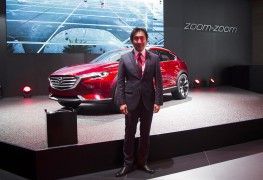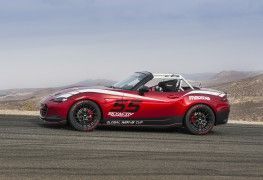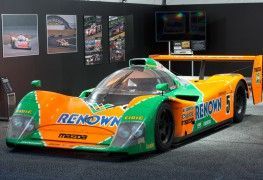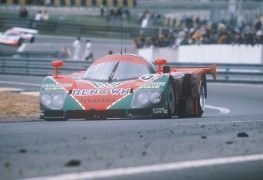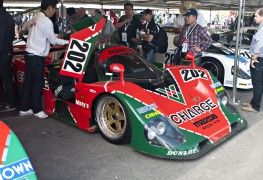Everything leads us to an origin: January 1920, Hiroshima prefecture, Toyo Cork Kogyo Company Inc. is founded from the remains of the bankrupt Abemaki Cork, a company specializing in the manufacture of artificial cork, as a substitute for natural cork. Unfortunately, in 1921, due to the sudden drop in demand for artificial cork, the company got into serious economic problems.
One of the founders of the company was Jugiro Matsuda. Matsuda, born in Hiroshima Prefecture, had emigrated to Osaka, where he began working in a foundry. There he invented a water pump called the "Matsuda pump" at the age of 31 (in 1906). The success of the design led to his promotion to director of the company, which was renamed the Matsuda Type Pump Limited Partnership. For reasons unclear, the company would eventually displace Matsuda from its management, and evolve organically to the present day, now called Teikoku (yes, Matsuda's first partnership still exists...).
Jugiro would not give up. After walking out the back door of the foundry that had brought him commercial success with his bomb design, in 1912 he established the Matsuda Works in Osaka, a company dedicated to the manufacture of weapons, a booming market in the inter-war period. The company's first large-scale contract was for the Type 99 rifle for the Japanese Army. Its success led to a second major contract with the Russian Tsar to manufacture similar rifles for the Russian Army.
Matsuda enjoyed success again, but far from his hometown. Faced with problems at the Toyo Cork Kogyo Company, Matsuda was encouraged by the rest of his partners to take control of the firm from 1921, which he did with courage. Immediately after returning to Hiroshima, he decided to give the firm's operations a major shake-up. The "Cork" (cork) was dropped from the company's name, and from 1929 the company redirected its efforts to manufacturing industrial machinery, creating everything from drills to hammers.
By the early 1930s, Matsuda was demonstrating his genius once again. He knew that Toyo Kogyo's survival depended on further diversifying its product portfolio and having something that made it truly distinctive. The race for Mazda's differentiating personality, which we talked about yesterday, was on. It did so with the company's first vehicle, the so-called MazdaGo, which was nothing more than a peculiar three-wheeled motorcar, mainly intended to transport goods.
 In fact, the MazdaGo is considered to be the first motorized cart manufactured on the planet. Since the company did not have a distribution network capable of covering Japan, it entered into an agreement with Mitsubishi for the distribution from 1931 of the device, which had an air-cooled twin-cylinder engine. The success of the product would be such that a genetically related derivative, the Dahiatsu Midget, would remain commercially active many decades later.
In fact, the MazdaGo is considered to be the first motorized cart manufactured on the planet. Since the company did not have a distribution network capable of covering Japan, it entered into an agreement with Mitsubishi for the distribution from 1931 of the device, which had an air-cooled twin-cylinder engine. The success of the product would be such that a genetically related derivative, the Dahiatsu Midget, would remain commercially active many decades later.
By the mid-1930s Matsuda entered into an agreement with the Sumitomo Group, a holding company with interests in mining and banking, as well as other industrial activities involving raw materials. Toyo Kogyo became a major supplier of mining drills and other tools to Sumitomo, which further increased its profitability and prosperity.
But then came World War II. The Japanese government called on Toyo Kogyo to join the war effort, and the company began producing weapons and vehicle parts in its factories. Fortunately for Matsuda, the factory was not considered a strategic target for Allied bombers, which spared it from further damage during the war. The Hiroshima atomic bomb would level the headquarters, but the company's main factory, located far enough away from the city, would be spared major damage. Even so, 400 employees would perish as a result of the bomb.
But out of the disaster came the spirit of revival so characteristic of Hiroshima and the companies in the area. By 1945, after the armistice, the firm would resume industrial activities. The manufacture of MazdaGo tricycles would be relaunched, which would bring economic income to the area, which in turn would serve to revive local commerce. Not only that, but Toyo Kogyo would become personally involved in the rebuilding of the town, something for which the locals felt, and still feel, grateful and connected to the brand.
During this period of rebirth, Jugiro's adopted son, Tsuneji Matsuda, would take over from his father. His interest in automobile production was more than evident, although he concentrated his early efforts on optimizing the factory's production.
By 1954, the company would sign an agreement with a technology supplier whose name seems more akin to "El Coyote", Acme Resin, a company specialising in fibreglass moulding. Taking advantage of the technological gain from this agreement, the company would begin development of its first car, the R360 coupe, a tiny vehicle designed to meet Japanese kei-car regulations, with a 16-horsepower rear-mounted twin-cylinder engine.
The commercial launch of the two-seater R360 from 1960 would be spectacular, but the competition would soon begin to press on with similar concepts. So Mazda launched the R360 Carol, a four-seater in 1962. The Carol employed a steel monocoque chassis with torsion beam suspension, powered by a two-cylinder engine with 18 horsepower. In its first year on the market it accounted for 67% of kei-car sales in Japan, strengthening Toyo Kogyo's industrial position.
It was the production of the first R360 that impressed the German ambassador when he visited the Mazda factory, and convinced him to broker the licensing of the NSU Wankel engine to Toyo Kogyo.
For six long years, while continuing to expand the product range and build a large new factory in Hiroshima, Toyo Kogyo worked tirelessly to bring its first Wankel-powered car to market, the Cosmo Sport, a "limited edition" two-seater sports car that would make a global impact and, as Matsuda had planned, serve as a tool to raise Mazda's profile around the world.
The company grew and began to expand its product lineup, entering the U.S. and Europe with a vengeance. Sales of Mazda-badged cars with rotary engines accounted for more than 90% of the company's total sales (the remaining 10% were cars with conventional four-stroke combustion engines). Ford, confident that there was a profitability bonanza, traveled to Hiroshima to try to work out a business deal to license Mazda Wankel engines for sale in the United States in 1971, but Mazda refused, and strengthened its position in 1972 with further sales growth, while claiming that the Wankel engine was "the perfect alternative to the high price of the Wankel engine.the perfect alternative to high gasoline prices in the U.S." because in a market accustomed to large displacement V8s, Mazda's Wankels offered lower fuel consumption, less weight, less vibration and better performance.
But then came the great cataclysm. The 1973 oil crisis would change the industry forever. Western manufacturers were quick to launch fuel-efficient four-cylinder engines, and the Wankel engine couldn't respond. Although it used less fuel than an equivalent V8, the stratified mixture engines with electronic injection from GM, Ford and other competitors were beating it in the United States, its main market.
Faced with the crisis and a lack of liquidity, Matsuda eventually gave in to a number of proposals. He sold a small stake in the company to Ford, which would manufacture a model at a Mazda plant. He licensed his Wankel engine to Suzuki for use in motorcycles. And finally, it struck a strategic deal with its "friends" at Sumitomo. The company that had been one of his major customers in the mid-1930s was investing a large amount of capital to keep Toyo Kogyo afloat.
The arrival of Sumitomo as a shareholder would lead to the departure of Matsuda, in favour of a new CEO, Yoshiki Yamasaki, with a more "entrepreneurial" and less dreamy vision. From that moment on Mazda would expand its offer of logical products, with traditional, well-built and cheap engines, with low fuel consumption and low maintenance costs, while reserving for the RX series of sports cars the task of keeping the Wankel engine alive.
All Japanese manufacturers would experience a commercial upturn in the late seventies, with the so-called "second oil crisis", which would make the United States look at Japanese manufacturers with different eyes, in search of higher quality and lower cost products.
By 1979, Ford would extend its control over Mazda to 24.9% of the company's shares, which would lead to the use of shared platforms and mechanics in many models, as well as factories. The great beneficiary, in this sense, would be Ford, which would have access to many engineering products with proven quality, without having to invest in their development, something that would continue to do for years, until the collaboration ceased.
The following decade saw Mazda continue to grow as a "small" international player. 1989 would also see the launch of the Miata, the roadster inspired by the neglected British convertibles, becoming one of Mazda's "savoir-faire". It was, in a way, the way to explain "how a Mazda should be".
But come the 1990s, Mazda was in trouble. Eighty per cent of its cars sold globally were produced in Japan, which made the cost of cars in international markets higher than in the rest of the industry, penalizing its results. Moreover, the range had become "too conventional", according to analysts at the time. The crisis hit hard, and Ford took advantage of it, investing more money to take control of 33.4% of Mazda, placing Mark Fields, no less, as CEO of the company.
Mazda resisted until then to layoffs, and proposed reductions in working hours and resistance to cover retirement leaves, but Fields would have to bet harder, and would end up closing a factory in Japan and reducing by 25% the Japanese production capacity of the company.
For the entry of the new decade, Mazda would undergo a major renewal in its range, with the launch of the new Mazda6, Mazda3 and RX-8, which would serve to reorient the company towards the so-called "zoom-zoom" principle of fun-to-drive cars. The immediate subsequent business results would be positive, and the company would move from the red to the black.
Mazda would begin to enter the Chinese market before the end of the first decade of this century, but the global crisis and Ford's strategy would affect it deeply. The Detroiters wanted to get rid of all their subsidiaries, and in a risky move to raise liquidity, they would sell their shareholdings in Volvo, Jaguar, Aston Martin and Mazda. Mazda, with the help, once again, of Sumitomo, would buy back the package offered by Ford (31% of its shareholding in two operations, one in 2008 and another in 2010, since it would keep more than two) and would carry out an ambitious share issue through a capital increase of more than 1,500 million euros no less, which would be a success, despite the initial doubts of analysts.
Part of the capital raised would be used to finance the construction of a new production plant in Mexico, with the idea of reducing dependence on Japan as a production hub, which is still a problem for the company today when the yen gains strength against other currencies.
The separation from Ford, as we told you in the previous installment, conditioned the use of shared platforms and engines, but Mazda solved this masterfully from a plan of modular platforms and engines to share across the product range. Yes, the SkyActiv technology we've already told you about.
Mazda remains a profitable company today, despite selling 1.4 million cars in the last fiscal year, defying some conventions about the minimum size of a "non-premium" automaker to survive. And industry figures like Carlos Ghosn and Sergio Marchionne (who has tried to acquire Mazda for FCA, we know) continue to say that manufacturers of less than 5 million cars a year will have a hard time staying in the game.
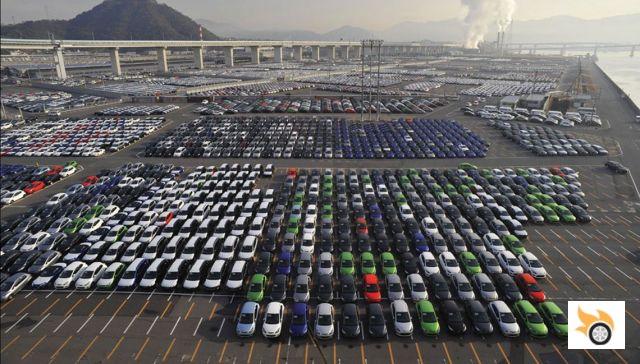
In the last year, and partly in response to these challenges of ever more copious new investments to stay in the game, Mazda has announced a strategic partnership with Toyota to share "technology investment" costs, although it was not made clear whether this was aimed at hybrid-only issues, or also on other fronts such as future platforms or mechanicals.
Be that as it may, this is the history to date of Mazda, and knowing the way it has had to do things "in its own style", we doubt that it will change overnight and we will see it integrated into a large corporation. It was born independent, working in its own way, and that's the way it seems to want to stay.
A tribute to Mazda and its sporting and technological heritage